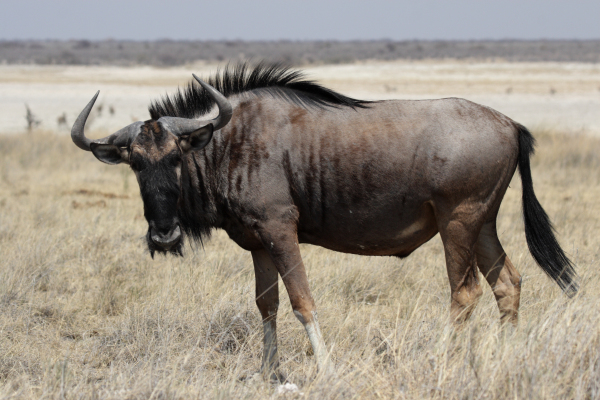
The Common Wildebeest(Connochaetes taurinus) is an African antelope that is classified in the mammalian order Artiodactyla, and the Bovidae family. The common Wildebeest is one of the most plentiful large mammals in Africa. The Common Wildebeest is more active during the morning and the late afternoon, but will rest during the hottest hours of the day. The Common Wildebeest can live up to 24 years.
The Common Wildebeest can run up to 80km/h(50 mph). Some of the main predators of Common Wildebeest are the African Wild Dog(Lycaon pictus), The Cheetah(Acinonyx jubatus), crocodiles, hyenas, the Lion(Panthera leo), and the Leopard(Panthera pardus).
Physical Characteristics
Both sexes have very similar shaped horns.
| Length | 1.7-2.4 m(5’7″-7’11”) |
| Shoulder Height | 1.15 -1.5 m(3’9″-4’11”) |
| Tail Length | 60 cm to 1 m(1’11”-3’3″) |
| Horn Length | 30-83 cm(12″-2’9″) |
| Weight | 118-290 kg(260-639 lbs.) |
Distribution and Habitat
Common Wildebeest inhabit Savannahs and grasslands, and live in Africa from southeastern regions to Kenya.
Breeding
The female Common Wildebeest reaches sexual maturity at 2-3 years old, the male reaches sexual maturity at 3-4 years old. When a male reaches maturity he tries to set up a small territory of his own which he will defend from other males. Most territories are of a temporary nature and fewer than half of the male population hold permanent territories. As they demarcate their territories and compete for females, males will fight for mating rights. When the males fight, they face up to each other with bent knees and exchange horn thrusts.
The mating season begins at the end of the rainy season. The female will give birth to usually one calf after a gestation period of approximately 8.5 months. Female wildebeest give birth in the middle of a herd rather than alone, and typically in the middle of the day. This allows time for the newborn to become steady on its feet before night falls and the predators become more active. Newborn calves weigh approximately 21 kilograms(47 pounds), and can stand about 15 minutes after birth. The calf will stay with its mother for 8 months. Female calves will stay with their mothers and other related females of the herd throughout their lives.
Diet
Common Wildebeest eat grass and plants, and drink 9 to 12 liters of water every 1 to 2 days.
Conservation Status
Scientists have determined that the Common Wildebeest’s conservation status is Least Concern. This species is considered to be a Keystone species, a Keystone species is one that other species in an ecosystem significantly depend on. Major human-related factors affecting populations include large-scale deforestation, the drying up of water sources, the expansion of settlements and poaching(illegal hunting). The Common Wildebeest is one Africa’s most iconic antelopes, and is one of the species that attracts tourists to countries where it can be observed, this places a great economic value on this animal which makes the conservation of this species a priority.
*An ecosystem is a biological community of interacting organisms and their physical environment.*
